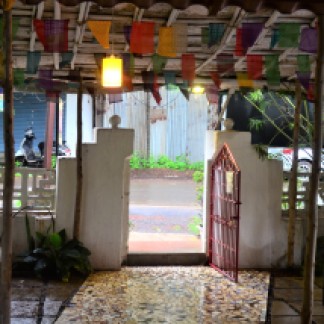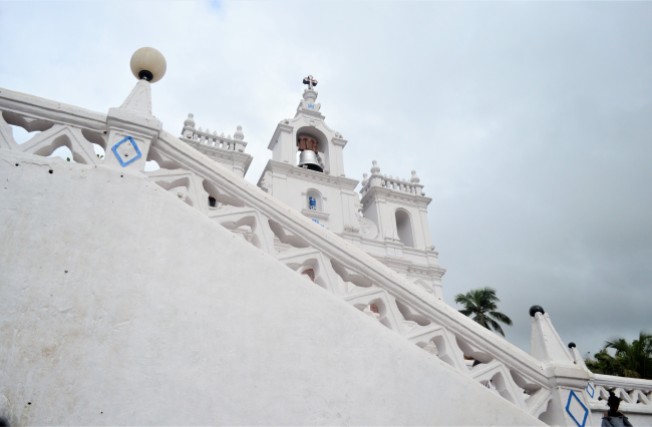When the monsoons arrive, they change Goa’s landscape into a dramatic vision—turning the foliage into lush green, soaking every bit of the parched land and making the distant hills grow verdant with eagerness. One can see nature’s abundance all around: be it the dark, heavy clouds almost touching the land about to burst or the surging tides flowing in a repetitive motion or the intoxicating petrichor—the sweet scent of wet earth—lingering in the air.
What I had known of Goa—for sun, sea and sands; the languid, balmy days; the evenings with a refreshing drink and pampering yourself with a bowl of steamed rice and prawn curry made with love. That quintessential place, known for its fun and frolic disposition and susegad way of life—what the locals define for quiet, contented life, living in unison, which originally derived from the Portuguese word Sossegado—grows quieter at this time of the year. All the commotion comes to a halt, shacks close, beach activities fizzle, and people retreat to the coziness of their homes.
The rain, however, seemed like a perpetual affair. On the first day of our arrival, we realized that this is not a great season for Goa. If you plan for a quietude and relaxing vacation, the monsoons will be a pleasure to experience. But if you carry in your satchel, a long list of things-to-do and a detailed itinerary for exploration, then it is a crazy time—cross my heart and hope to die!
While we waited for the rain to settle, I played with the house cats, patted the dogs, chased after them to take pictures and walked around the place—our home for the next four days—a cozy bed and breakfast run by a French lady, who has spent her last forty-two years in this tropical state.

Goan Vaddo: Getting a hang of the village life
Luckily, the rain stopped. We wasted no time to hop into our scooter and head to Assagao. Our first stop was at Ruta’s Roadhouse Café. Enticed by the lovely weather, we treated ourselves to cups of hot tea and a platter of spaghetti. With the unpretentious furniture, muted wall paints and a homely setting, the café bore a modest appearance. Unlike the good reviews, the placed turned out to be a little disappointing for us: pricey and poor service. It happens. I have come across popular cafes that never justified their popularity.
Mostly, the reviews seem to be an eclectic mix of taste; how photogenic and Instagram-able the place is; the atmosphere; the crowd; perhaps, ignoring the three simple things—cost, taste and quality.
We rode around the area, stopping by few shops. Assagao is a quaint, inland area in North Goa, flanked by Anjuna and Mapusa. It has become a promising place and hotspot for artists, designers, gourmet food outlets, bistros like the popular Gunpowder restaurant. Places like The Project Café, Cheshire Cat Gallery, these swanky, chic stores have found its audience and acceptance in this pretty village.
In Konkani, Goa’s spoken language, a vaddo means village. Similarly, velha means old and balcao means balcony. It is good to pick up few local lingos on the way, particularly, when you often find them on signposts and landmarks and sometimes, without any reason. We took a trip through many vaddos of northern Goa: Anjuna, Mapusa, Sangolda, Porvorim, Parra. The driver who picked us from the airport said that Sangolda is where the reputed, aristocratic families lived. “The area is posh and got a good reputation if you want to buy a house,” he remarked.
While there are the usual, crowded places like Baga and Calangute, the vaddos are silent, away from the noise and life can be spent watching the roosters tiptoeing in the backyard; fishermen coming back from their early morning catch in the seas, drying their nets; women feeding their birds, getting on with the daily chores; cows snuggling up and sitting in the middle of the road. Days don’t seem to be dull at all.
Goa shares an intimate relationship with every kind of traveler—whether you are a beach lover; a party goer; architecture admirer; history aficionado; a bohemian wanderer; daydreamer; or a sheer hedonist—this coastal beauty has a lot to offer. This land has allured people of all types—explorers, settlers, vagabonds, freethinkers, seekers, Goa has evolved into a global community—becoming home for many.
Velha Goa and Fontainhas: Embarking and unearthing many facets
Old Goa is predominantly characterized by the churches, cathedrals, remnants of Baroque architecture, and heritage sites like Basilica of Bom Jesus, Se Cathedral, St. Augustine Tower. Many centuries back, the Portuguese had embarked on a long voyage to arrive in a small coastal region flanked by the Arabian sea, raised a community, built great architecture and left behind inspiration, whose traces can be seen in the traditional Goan houses and its cuisines.
This reminds me of Pondicherry, whose architecture, food and culture had strong imprints of French influence. What was quite remarkable was the resemblance that I found between Fontainhas—the picturesque neighborhood of Panjim; and Pondicherry’s White Town. The pattern of interconnecting streets; the colors of the buildings; and the similar colonial architecture that both exhibited.
When you visit this area, which you must, keep in mind that most of the cafes and shops between 1 to 3 p.m., are closed. This is a siesta time and a way to unwind, something which I felt were the characteristics of the susegad way of life. After we took a tour of the Latin quarters of Fontainhas, our immediate stop was at the beautiful, pristine Our Lady of the Immaculate Conception Church, located right in the heart of Panjim city.



Till we meet again
The day was great, we explored the neighborhood, visited the Broadway Book Center, stopped by galleries and bought few reproduced works of Goa’s famous homegrown artist Mario Miranda. If you are an avid collector of artifacts, those azulejos hand-painted tiles will make a great addition.
Goa is certainly beyond feni, party, sunburns and sundowner. It thrives on its bountiful personality and has many sides to her—from bird sanctuary to spice plantations to mangrove walks to historic relics to culture, architecture and cuisines—Goa has it all. While this extraordinary situation has held us, making us feel restricted, I am still dreaming and making itineraries and spending my days visualizing about the day I arrive in this beautiful place with that childlike excitement carrying her satchel that treasures her long list of to-dos.


































Thank you.you beautifully explained Goa.I visualize Goa,what a beautiful and and natural! amazing!
LikeLike